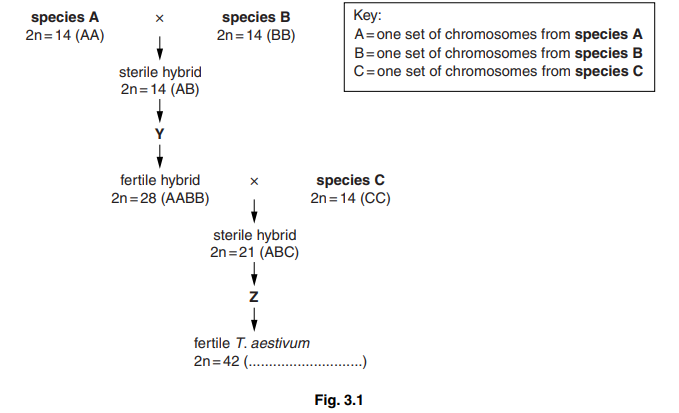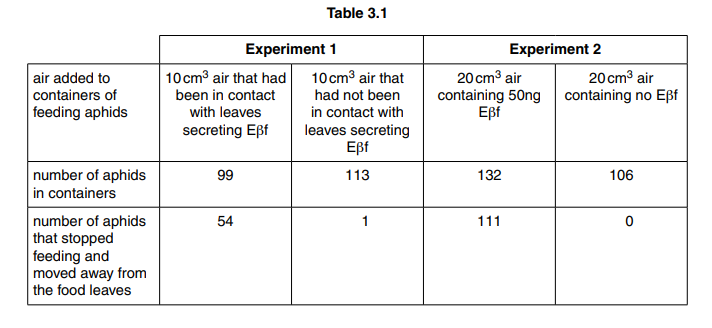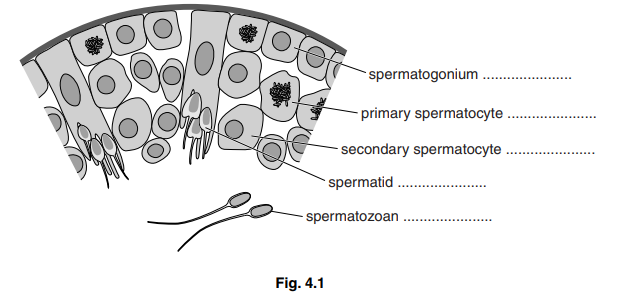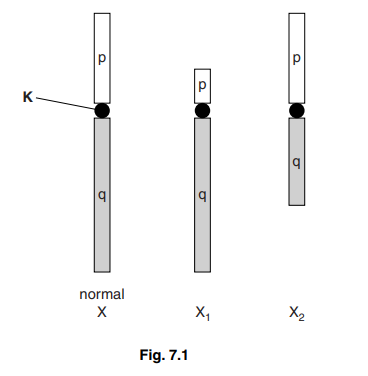Question
(a) Wheat, Triticum aestivum, owes its origin to hybridisation involving three different, but related, species of grass, A, B and C.
Each of these species had seven pairs of chromosomes (2n = 14).
The hybridisation process is shown in Fig. 3.1.

(i) Using the symbols in the key, complete Fig. 3.1 by writing in the chromosome sets of T. aestivum. [1]
(ii) At the points labelled Y and Z in the hybridisation process, a fertile hybrid was produced from a sterile hybrid.
Explain why the hybrid (AB) is sterile and what occurred at the point labelled Y in Fig. 3.1.[4]
(b) In 2012, permission was granted for a field trial in the UK of genetically modified T. aestivum. The wheat carries a gene, taken from peppermint plants, that results in the wheat leaves releasing a volatile, non-toxic chemical, (E)-β-farnesene (Eβf), into the
atmosphere.
Eβf is not only produced by various species of plants. It is also secreted by aphids when they are disturbed by a predator.
Two experiments have been performed into the effect of Eβf on the behaviour of aphids feeding on leaves in closed containers.
Experiment 1
Either 10 cm3 of air from a syringe that contained plant leaves that secrete Eβf
or 10 cm3 of air from a syringe with no such leaves
was added to the containers of feeding aphids.
Experiment 2
Either 20 cm3 of air containing 50ng of Eβf
or 20 cm3 of air containing no Eβf
was added to the containers of feeding aphids.
In both experiments, the number of aphids that stopped feeding and moved away from the food leaves was counted. The results are shown in Table 3.1.

(i) Discuss the extent to which the results of these experiments support the idea that Eβf is an alarm signal for aphids.[4]
(ii) Other experiments show that Eβf attracts predators of aphids, such as ladybirds.
Explain how growing genetically modified wheat secreting Eβf could increase the yield of wheat.[3]
(iii) Suggest why growing this genetically modified wheat might be acceptable to people who object to the growth of genetically modified insect-resistant maize or cotton.[3] [Total: 15]
Answer/Explanation
Ans:
3 (a) (i) AABBCC ;
(ii) meiosis unsuccessful (in, sterile hybrid/AB) ;
gametes not formed ;
bivalents cannot form/ chromosomes cannot pair up/ chromosomes are not homologous ;
polyploidy occurs / chromosomes double ; A tetraploid
failure of cell division/ all chromosomes in one daughter cell ; A description
chromosomes can now form pairs / gametes can be formed/ meiosis can be completed ;
(b) (i) in presence of Eβf large number aphids, stop feeding/move ;
in absence of Eβf, few/ no, aphids, stop feeding/ move ;
air in Experiment 1, has other chemicals / not pure Eβf or air in Experiment 2 has only Eβf ;
Eβf concentration in Experiment 2 may be unnaturally high or Eβf concentration unknown in Experiment 1 ;
different volumes of air in Experiment 1 and Experiment 2 ;
comparative data quote ;
e.g.
55% versus 84% or 54 out of 99 versus 111 out of 132
54.5% versus 0.9% or 54 out of 99 versus 1 out of 113
84% versus 0% or 111 out of 132 versus 0 out of 106
(ii) Eβf stops aphids settling ;
Eβf attracts, predators of aphids / ladybirds ;
attacked aphids secrete more Eβf ;
aphids not, eating/ taking nutrients from, wheat ;
(iii) gene/Eβf, already in, peppermint/ various plant species ;
Eβf not, toxic / harmful to human health ;
no new chemical added to human diet ;
does not kill insects (unlike Bt maize or cotton) ;
aphids still available for, predators / food web ;
Question
(a) Spermatogenesis takes place in the seminiferous tubules, in the testis. Fig. 4.1 is a diagram showing some of the cells in a small sector of a seminiferous tubule.

(i) On Fig. 4.1, state whether each of the labelled cells is haploid or diploid.
Write n if the cell is haploid and 2n if the cell is diploid.[2]
(ii) Spermatogenesis involves meiosis, mitosis, growth and maturation.
State which of these processes is involved in each of the following steps in spermatogenesis.[2]
spermatogonium to primary spermatocyte
spermatid to spermatozoan (sperm)
(iii) State one role of a Sertoli cell.[1]
(b) In some men, spermatogenesis does not take place successfully and the sperm that are produced are unable to fertilise an egg. A form of IVF called intra-cytoplasmic sperm injection (ICSI) may enable them to father a child with their partner.
In ICSI, a sperm cell is inserted into a secondary oocyte using a very tiny needle.
Outline the treatment required in order to obtain mature oocytes as part of an IVF procedure.[4]
(c) One approach to helping an infertile man to father children is to extract immature spermatids from his testes and culture them in the laboratory, in conditions that may increase the number of them that develop into functioning sperm. These can then be used
for IVF.
An investigation was carried out to see if adding reproductive hormones to a culture of immature spermatids affects their development.
Samples of spermatids were collected from men in whom the spermatids did not normally develop into functioning sperm. The spermatids were cultured in a suitable liquid medium, kept at 30 °C.
The samples were divided into four groups. No hormones were added to one group. FSH, testosterone or both were added to the other groups. The percentage of spermatids that developed into elongated cells in each group after 24 hours and 48 hours was
calculated. The results are shown in Table 4.1.

(i) With reference to Table 4.1, describe the effects of adding reproductive hormones on the development of the spermatids after 48 hours.[4]
(ii) Suggest a reason for the apparent reduction in the percentage of elongated cells between 24 hours and 48 hours in some of the samples.[1]
(iii) Suggest why the culture medium was maintained at a temperature of 30 °C, and not at core body temperature (37 °C).[2] [Total: 16]
Answer/Explanation
Ans:
4 (a) (i) spermatagonium – 2n
primary spermatocyte – 2n
secondary spermatocyte – n
spermatids – n
spermatozoan – n ;;
all five correct for two marks
three or four correct for one mark
(ii) (spermatogonium to primary spermatocyte) growth / mitosis ;
(spermatid to sperm) maturation ;
(iii) any 1 from
provide nutrients for sperm(atid) ;
protect sperm from attack from immune system ;
regulation of, sperm production/FSH ;
AVP ; e.g. removes excess cytoplasm during sperm maturation/
guides sperm to centre of tubule
(b) FSH ;
(hormone) given to stimulate follicle development ;
GnRH agonists /GnRH receptor antagonists ;
to prevent, LH surge/ ovulation ;
human chorionic gonadotrophin ;
(hormone) given to stimulate maturation of oocytes ;
(mature oocytes) collected from ovaries (just before ovulation) ;
ref. use of, fine tube/needle/ ultrasound ;
(c) (i) FSH (alone)/FSH + testosterone, increases development (of spermatids into, spermatozoa/elongated cells) ;
testosterone (alone) has very little effect ;
FSH + testosterone causes greatest increase of development ;
use of, comparative/manipulated, figures ;
(ii) (reduction is very small so) may be, insignificant/random/ due to chance ; (some cells) may have died ;
(iii) temperature, similar to testes / in range 30°C to 35°C/ lower than core ; spermatozoa production, will not proceed at 37°C/ at high temperature ;
Question
Occasionally during meiosis, homologous chromosomes fail to separate at anaphase. This is known as non-disjunction. Turner’s syndrome is the most common chromosome mutation in human females. It can occur due to non-disjunction in meiosis during
gametogenesis. Some resulting gametes will be missing an X chromosome.
Some forms of Turner’s syndrome occur when one of the pair of X chromosomes is not missing but has become damaged. The damaged X chromosome may have been broken and re-formed so that part of its structure is lost.
Fig. 7.1 is a diagram of a normal X chromosome and two forms of ‘damaged’ X chromosomes, X1 and X2.
- In X1, a section of the ‘p’ arm of the chromosome is missing. This deletion leads to reduced height of the female and abnormalities such as narrowing of the aorta.
- In X2, a section of the ‘q’ arm of the chromosome is missing. This deletion leads to little or no development of the ovaries.

(a) Name structure K.[1]
(b) Explain why X1 and X2 result in different phenotypes.[2]
(c) Mothers with the X1 form of Turner’s syndrome can pass on the chromosome mutation to their daughters but not to their sons.
Complete the genetic diagram below to show how the chromosome mutation X1 may be passed on to daughters from a mother with Turner’s syndrome.[4]
parental female with normal male
phenotypes Turner’s syndrome
parental
genotypes XX1
gametes
genotypes of
daughters
phenotypes of
daughters
[Total: 7]
Answer/Explanation
Ans:
7 (a) centromere ;
(b) idea that different genes, are present/missing ; R alleles
different, proteins / poypeptides, produced/missing ;
(c) XY ;
X X1 X Y ;
XX XX1 ;
normal Turner’s ;
